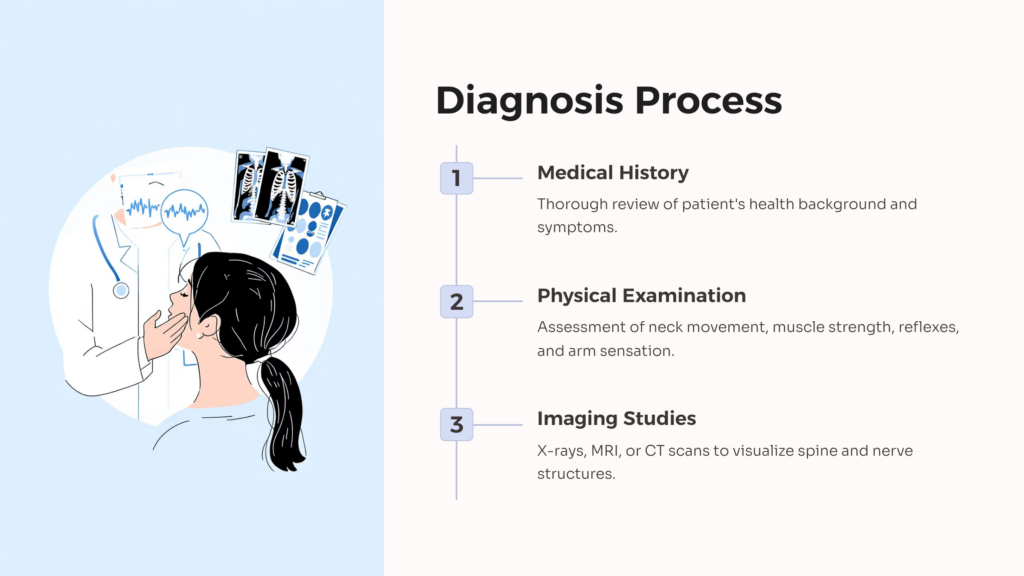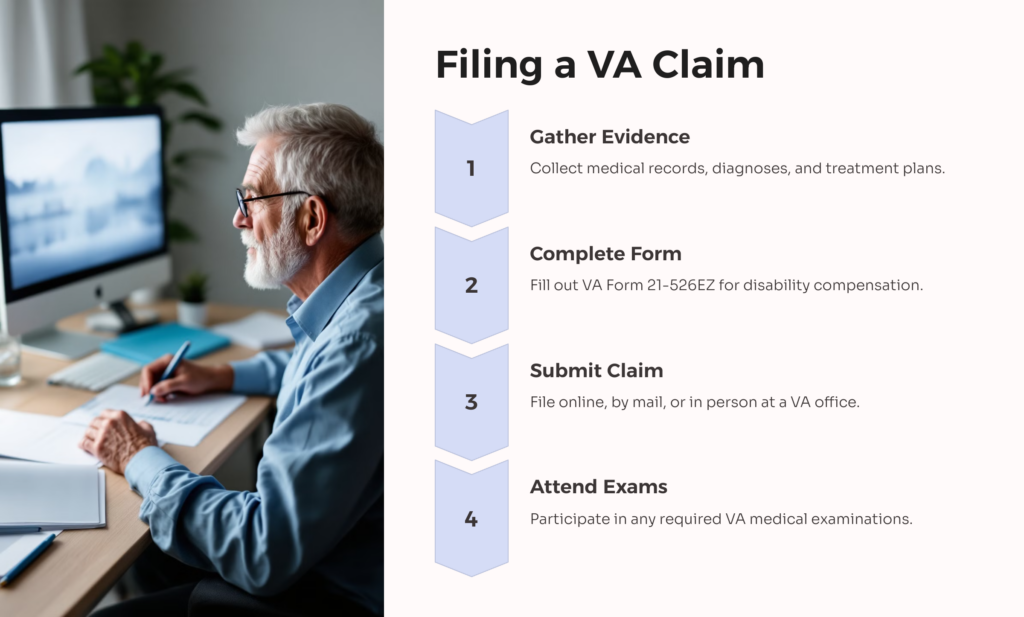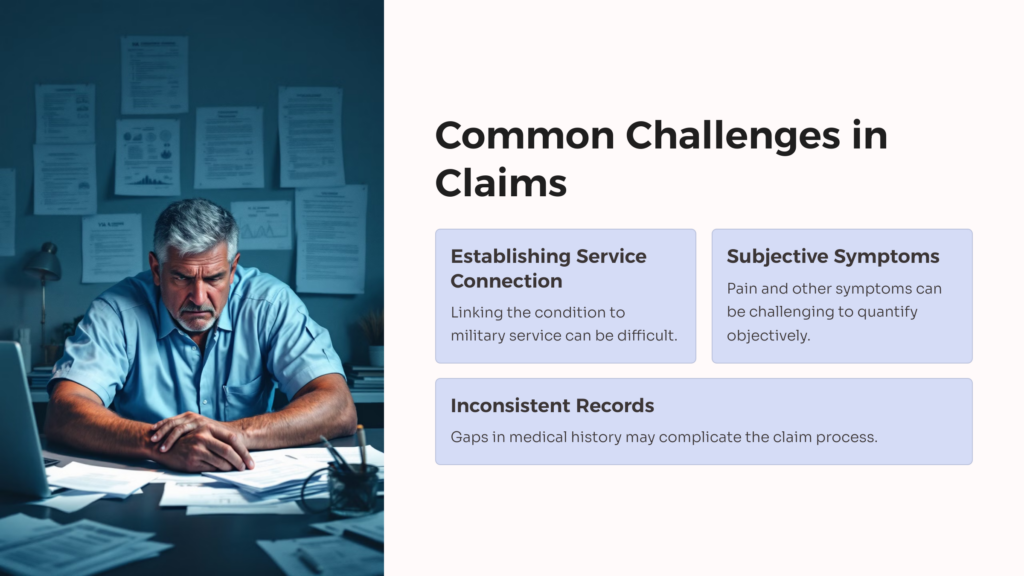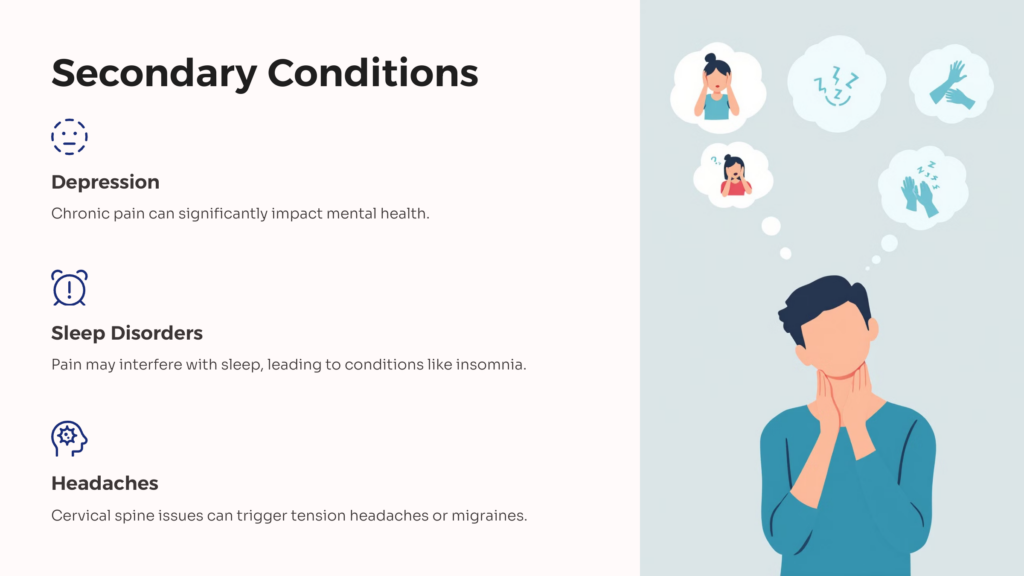Cervical radiculopathy is a condition that affects many veterans, often as a result of their military service. It occurs when a nerve in the neck (cervical spine) becomes compressed or irritated as it branches away from the spinal cord. This compression can lead to pain, weakness, numbness, or tingling that radiates along the path of the affected nerve.
For veterans, cervical radiculopathy can be particularly troublesome, as it may interfere with daily activities and job performance. The condition can result from various causes, including herniated discs, bone spurs, or degenerative changes in the spine. These issues may develop over time due to the physical demands of military service, such as carrying heavy equipment or repetitive motions.
Understanding cervical radiculopathy is crucial for veterans seeking VA disability benefits. It’s important to recognize that this condition can have a significant impact on quality of life and may be eligible for compensation through the Department of Veterans Affairs.
Common Symptoms of Cervical Radiculopathy
Veterans experiencing cervical radiculopathy may encounter a range of symptoms that can vary in intensity and location. The most common symptom is pain that radiates from the neck into the shoulder, arm, or hand. This pain is often described as sharp, burning, or electric-like.
Numbness and tingling sensations are also frequent complaints. These feelings may extend from the neck down to the fingertips, following the path of the affected nerve. Some veterans report weakness in the arm or hand, which can make it difficult to grip objects or perform tasks that require fine motor skills.
Other symptoms may include:
- Neck stiffness or reduced range of motion
- Muscle spasms in the neck or shoulder area
- Headaches, particularly at the base of the skull
- Increased pain with certain neck movements or positions
It’s important for veterans to document these symptoms thoroughly, as they play a crucial role in determining the VA disability rating for cervical radiculopathy. Keeping a symptom journal can be helpful when filing a VA claim or discussing the condition with healthcare providers.
Diagnosing Cervical Radiculopathy

Proper diagnosis of cervical radiculopathy is essential for veterans seeking VA disability benefits. The process typically begins with a thorough medical history and physical examination. During the exam, a healthcare provider will assess neck movement, muscle strength, reflexes, and sensation in the arms and hands.
Imaging studies are often necessary to confirm the diagnosis and identify the underlying cause. These may include:
- X-rays: To check for bone spurs or narrowing of the disc spaces
- Magnetic Resonance Imaging (MRI): To visualize soft tissues, including nerves and discs
- Computed Tomography (CT) scan: To provide detailed images of the bone structures in the neck
In some cases, additional tests may be required. An electromyography (EMG) or nerve conduction study can help determine which specific nerves are affected and the severity of the compression.
For veterans, it’s crucial to undergo these diagnostic procedures and obtain clear documentation of the results. This medical evidence is vital when filing a VA claim for cervical radiculopathy and can significantly impact the assigned disability rating.
The VA Disability Rating System Explained
The VA disability rating system is designed to compensate veterans for the average impairment in earning capacity resulting from service-connected injuries or diseases. For conditions like cervical radiculopathy, the VA uses a percentage-based scale to determine the level of disability and corresponding compensation.
Ratings are assigned in 10% increments, ranging from 0% to 100%. A 0% rating means the condition is service-connected but doesn’t significantly impact earning capacity, while a 100% rating indicates total disability. For cervical radiculopathy, ratings typically fall between 10% and 60%, depending on the severity of symptoms and their impact on daily life.
The VA considers several factors when assigning a rating:
- Severity of symptoms
- Frequency and duration of episodes
- Impact on work and daily activities
- Results of medical examinations and tests
It’s important to note that the VA rating system is complex, and cervical radiculopathy may be evaluated under different diagnostic codes depending on the specific nerves involved and associated symptoms. Understanding this system can help veterans navigate the claims process more effectively and ensure they receive appropriate compensation for their condition.
VA Rating for Cervical Radiculopathy
The VA typically rates cervical radiculopathy under the diagnostic codes for diseases of the peripheral nerves, specifically those affecting the upper radicular group (5th and 6th cervicals). The most commonly used codes are 8510, 8610, and 8710, which correspond to paralysis, neuritis, and neuralgia of the upper radicular group, respectively.
The rating criteria are as follows:
- 20%: Mild incomplete paralysis
- 40% (dominant arm) or 30% (non-dominant arm): Moderate incomplete paralysis
- 50% (dominant arm) or 40% (non-dominant arm): Severe incomplete paralysis
- 70% (dominant arm) or 60% (non-dominant arm): Complete paralysis
According to VA.gov, “when the involvement is wholly sensory, the rating should be for the mild, or at most, the moderate degree.” This means that if a veteran’s symptoms are limited to pain, numbness, or tingling without significant weakness or loss of function, the rating will typically be 20% or at most 40% (for the dominant arm).
It’s important to note that the terms “mild,” “moderate,” and “severe” are not explicitly defined by the VA. Instead, they are based on the overall disability picture presented by the medical evidence and the veteran’s reported symptoms. This is why thorough documentation of symptoms and their impact on daily life is crucial when seeking a VA rating for cervical radiculopathy.
How to File a VA Claim for Cervical Radiculopathy

Filing a VA claim for cervical radiculopathy requires careful preparation and documentation. Here’s a step-by-step guide to help veterans navigate the process:
1. Gather medical evidence: Collect all relevant medical records, including diagnoses, treatment plans, and imaging results. Make sure you have a clear diagnosis of cervical radiculopathy from a qualified healthcare provider.
2. Document symptoms and limitations: Keep a detailed journal of your symptoms, including frequency, severity, and how they impact your daily life and work ability. This personal account can be valuable evidence.
3. Complete VA Form 21-526EZ: This is the Application for Disability Compensation and Related Compensation Benefits. You can file online through the VA’s eBenefits portal, by mail, or in person at a VA regional office.
4. Include a personal statement: Write a statement explaining how your cervical radiculopathy is related to your military service and how it affects your life. Be specific and provide examples.
5. Submit buddy statements: If possible, include statements from fellow service members, family, or friends who can attest to your condition and its impact on your life.
6. Attend VA examinations: The VA may schedule you for a Compensation and Pension (C&P) exam. Attend this exam and be honest about your symptoms and limitations.
7. Follow up: After submitting your claim, keep track of its progress through the eBenefits portal or by contacting the VA directly. Be prepared to provide additional information if requested.
Remember, the key to a successful claim is providing comprehensive, well-documented evidence of your condition and its service connection. Don’t hesitate to seek assistance from a Veterans Service Organization (VSO) or a qualified VA disability attorney if you need help with your claim.
Common Challenges in VA Claims for Cervical Radiculopathy

Veterans often face several challenges when filing VA claims for cervical radiculopathy. Being aware of these potential obstacles can help you better prepare your claim and increase your chances of a favorable outcome.
One common challenge is establishing a service connection. If cervical radiculopathy wasn’t diagnosed during active duty, you’ll need to provide evidence linking the condition to your military service. This may require obtaining a medical opinion that explains how your service activities contributed to the development of cervical radiculopathy.
Another issue is the subjective nature of pain and other symptoms. Since the VA relies heavily on objective medical evidence, it can be difficult to convey the full impact of your condition. To address this, provide detailed descriptions of your symptoms and how they affect your daily life, work, and relationships.
Inconsistent medical records can also pose a problem. If you’ve seen multiple healthcare providers or have gaps in your treatment history, it may be challenging to present a clear picture of your condition’s progression. Try to obtain all relevant medical records and explain any gaps in treatment.
Lastly, veterans sometimes struggle with the VA’s rating criteria. The distinction between “mild,” “moderate,” and “severe” incomplete paralysis can be unclear. To overcome this, focus on providing specific examples of how your symptoms impact your functionality, rather than just describing pain levels.
By anticipating these challenges and addressing them proactively in your claim, you can improve your chances of receiving an appropriate VA rating for your cervical radiculopathy.
Secondary Conditions Related to Cervical Radiculopathy
Cervical radiculopathy can often lead to or exacerbate other conditions, which may be eligible for secondary service connection. Understanding these secondary conditions is crucial for veterans seeking comprehensive VA disability benefits.

Some common secondary conditions include:
1. Depression or anxiety: Chronic pain and limited mobility can significantly impact mental health.
2. Sleep disorders: Pain and discomfort may interfere with sleep, leading to conditions like insomnia.
3. Headaches: Cervical spine issues can trigger tension headaches or migraines.
4. Carpal tunnel syndrome: Altered arm and hand positioning due to neck pain can contribute to this condition.
According to VA Claims Insider, secondary service connection can be established if a service-connected disability causes or aggravates another condition. For example, if your cervical radiculopathy leads to depression, you may be eligible for additional compensation for the mental health condition.
When filing for secondary conditions, it’s important to provide medical evidence linking the secondary condition to your service-connected cervical radiculopathy. This often requires a medical opinion from a healthcare provider explaining the relationship between the conditions.
Remember, each secondary condition can potentially increase your overall VA disability rating, leading to higher compensation. Be sure to discuss any additional symptoms or conditions with your healthcare provider and include them in your VA claim if appropriate.
Appealing a Denied VA Claim for Cervical Radiculopathy
If your VA claim for cervical radiculopathy is denied or you receive a lower rating than expected, you have the right to appeal the decision. The appeals process can be complex, but understanding your options can help you navigate it more effectively.
As of February 2019, the VA implemented the Appeals Modernization Act (AMA), which provides three options for appealing a decision:
1. Higher-Level Review: A senior VA reviewer will take a fresh look at your claim. No new evidence can be submitted.
2. Supplemental Claim: You can submit new and relevant evidence to support your claim.
3. Appeal to the Board of Veterans’ Appeals: You can appeal directly to the Board, with options for a direct review, submission of additional evidence, or a hearing.
When appealing, focus on addressing the specific reasons for the denial or low rating. This might involve:
- Obtaining additional medical evidence
- Securing a more detailed medical opinion linking your condition to service
- Providing clearer documentation of how your symptoms impact your daily life
Consider seeking assistance from a Veterans Service Organization (VSO) or a VA-accredited attorney. They can help you understand the strengths and weaknesses of your claim and develop a strategy for your appeal.
Remember, persistence is key. Many veterans succeed in their appeals, especially when they provide comprehensive evidence and clearly articulate how their condition meets the VA’s rating criteria.
Tips for Increasing Your VA Rating
If you believe your current VA rating for cervical radiculopathy doesn’t accurately reflect the severity of your condition, there are several steps you can take to potentially increase your rating:
1. Keep detailed records: Document all symptoms, flare-ups, and how the condition affects your daily life and work. This information can be crucial during reevaluations.
2. Attend regular medical appointments: Consistent medical treatment creates a record of your ongoing issues and shows that your condition requires continued care.
3. Request a new C&P exam: If your condition has worsened since your last evaluation, you can request a new Compensation and Pension examination.
4. Obtain a private medical opinion: A detailed report from a specialist can provide valuable evidence for your claim, especially if it addresses the specific rating criteria used by the VA.
5. Consider secondary conditions: As mentioned earlier, file claims for any secondary conditions related to your cervical radiculopathy.
6. Be honest about your worst days: During examinations and in your documentation, describe how your condition affects you on your worst days, not just on average days.
7. Understand the rating criteria: Familiarize yourself with the specific criteria used to rate cervical radiculopathy and ensure your evidence addresses these points.
8. File for individual unemployability: If your cervical radiculopathy significantly impacts your ability to work, you may be eligible for Total Disability based on Individual Unemployability (TDIU).
Remember, increasing your VA rating requires strong medical evidence and clear documentation of how your condition impacts your life. Don’t hesitate to seek professional assistance if you’re struggling with the process.
Frequently Asked Questions About Cervical Radiculopathy VA Ratings
Here are some common questions veterans often have about cervical radiculopathy VA ratings:
Q: Can I receive separate ratings for cervical radiculopathy in both arms?
A: Yes, if you have radiculopathy affecting both arms, you can receive separate ratings for each arm.
Q: How often will the VA reevaluate my cervical radiculopathy rating?
A: The VA may schedule routine future examinations, typically every 2-5 years, unless your condition is considered permanent and total.
Q: Can my cervical radiculopathy rating be reduced?
A: Yes, if the VA determines your condition has improved. However, they must provide clear evidence of sustained improvement before reducing your rating.
Q: Is cervical radiculopathy considered a presumptive condition?
A: Cervical radiculopathy is not typically considered a presumptive condition. You’ll need to establish a direct service connection or secondary service connection.
Q: How does the VA distinguish between cervical radiculopathy and other neck conditions?
A: The VA relies on specific diagnostic criteria and medical evidence to distinguish cervical radiculopathy from other neck conditions. Clear imaging results and nerve conduction studies are often crucial.
Q: Can I work with a cervical radiculopathy VA rating?
A: Yes, many veterans with cervical radiculopathy continue to work. However, if your condition significantly impairs your ability to work, you may be eligible for Total Disability based on Individual Unemployability (TDIU).
Remember, every veteran’s situation is unique. If you have specific questions about your case, consider consulting with a VSO or VA-accredited attorney for personalized advice.
Resources for Veterans with Cervical Radiculopathy
For veterans dealing with cervical radiculopathy, numerous resources are available to provide support, information, and assistance with VA claims:
1. VA Health Care System: Offers comprehensive medical care, including specialized services for spinal conditions. Visit www.va.gov/health for more information.
2. Veterans Service Organizations (VSOs): Organizations like the Disabled American Veterans (DAV), Veterans of Foreign Wars (VFW), and American Legion offer free assistance with VA claims.
3. VA’s eBenefits Portal: Allows veterans to manage their benefits, file claims, and track claim status online. Access it at www.ebenefits.va.gov.
4. National Resource Directory: Provides a comprehensive database of resources for veterans, including medical care and support services. Visit www.nrd.gov.
5. Vet Centers: Offer counseling and support for veterans dealing with the psychological impacts of chronic pain conditions. Find a center at www.vetcenter.va.gov.
6. VA Caregiver Support: Provides resources for family members caring for veterans with disabilities. Learn more at www.caregiver.va.gov.
7. Veterans Crisis Line: Offers 24/7 confidential support for veterans in crisis. Call 1-800-273-8255 and Press 1, or visit www.veteranscrisisline.net.
Remember, you’re not alone in navigating life with cervical radiculopathy. These resources can provide valuable support and guidance throughout your journey. Don’t hesitate to reach out and take advantage of the services available to you as a veteran.
Check us out at AllVeteran.com for more, and take our free medical evidence screening today.
 AllVeteran.com Advisors
AllVeteran.com Advisors
With expertise spanning local, state, and federal benefit programs, our team is dedicated to guiding individuals towards the perfect program tailored to their unique circumstances.











